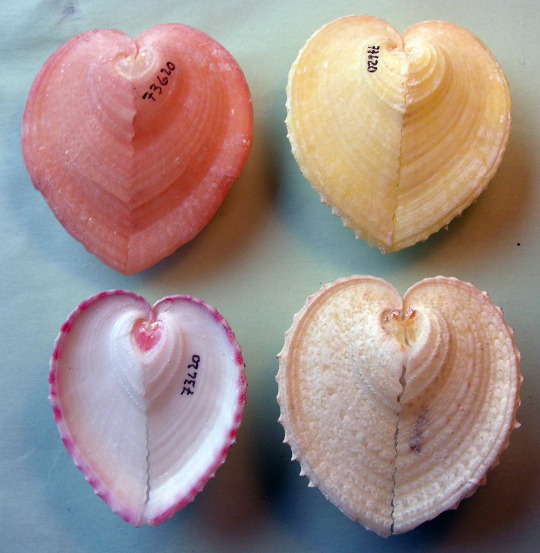By Timothy A. Pearce
The phrase “cockles of your heart” refers to the cockle-like ventricles of the heart. But the cockles that Mary quite contrary had in her garden, and the cockles being sold by Molly Malone, are bivalve mollusks that have heart-shaped shells. Of the cockles, one of the most heart-shaped is Corculum cardissa, also known as the heart cockle.

Corculum cardissa and the related giant clams (genus Tridacna) have microscopic dinoflagellate algae living inside their bodies (in the mantle, gills, and the liver).
Remarkably, the shells of Corculum cardissa have tiny translucent windows that allow light to penetrate so the algae can photosynthesize. The cockle gets food from the algae, and the algae get a safe place to live. They live together in symbiosis (as happy as an alga).
The windows appear to direct and focus light onto the parts of the clam body containing algae, rather than simply dispersing light (Carter & Schneider 1997).
Both Corculum cardissa and the giant clams live in the Indo-Pacific region. They inhabit shallow water because there is not enough light below about 20 m depth for their algae.
The giant clams and heart cockles (Corculum) are perhaps the only bivalves having a symbiotic relationship with dinoflagellates (Farmer et al., 2001).
Second to the corals, these clams are the best-studied systems of photosynthetic symbionts in animals.
Now there is a story to warm the cockles of your heart on these cold winter days!
Timothy A. Pearce is Curator of Collections, Section of Mollusks at Carnegie Museum of Natural History. Museum employees are encouraged to blog about their unique experiences and knowledge gained from working at the museum.
Literature
Carter, J.G. & Schneider, J.A. 1997. Condensing lenses and shell microstructure in Corculum, (Mollusca: Bivalvia). Journal of Paleontology, 71(1): 56-61.
Farmer, M.A., Fitt, W.K. & Trench, R.K. 2001. Morphology of the symbiosys between Corculum cardissa (Mollusca: Bivalvia) and Symbiodinium corculorum (Dinophyceae). Biological Bulletin, 200: 336-343.
